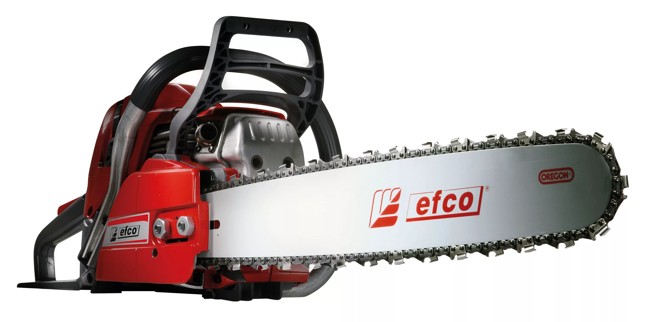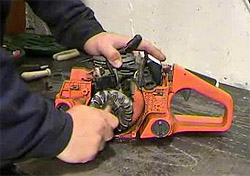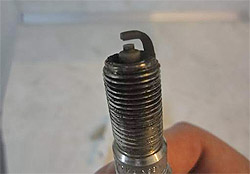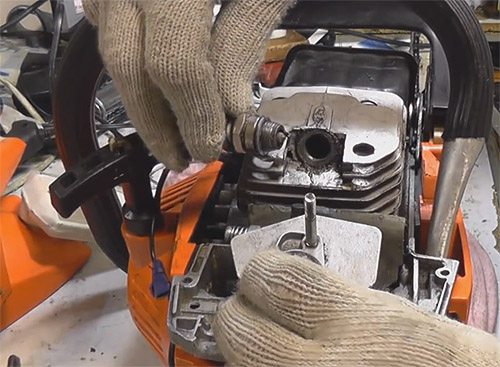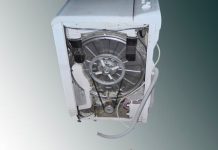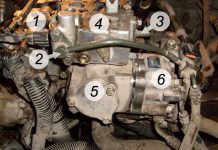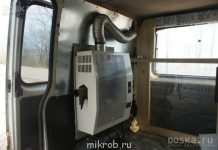It often happens that during prolonged operation, the walls of the exhaust pipe are covered with carbon deposits, which prevents the free exit of exhaust gases.
In this case, remove the muffler (if possible) and wash it with detergents, then dry thoroughly with a hairdryer.
ATTENTION! Carbon deposits contain carcinogens. During dry brushing, it can enter the lungs and pose a threat to your health.
Carbon deposits are usually caused by an incorrect gasoline-oil ratio or the use of poor quality and incompatible oil.
Carefully read the instruction manual for your chainsaw to prevent this from happening in the future.
The worn out cylinder and piston, the appearance of scratches and seizures on their surface, wear of the piston rings or crankshaft bearings - all these are very serious damages. As a result, they lead to a pressure drop in the cylinder. In this case, it will be very difficult to start the engine.
Without disassembly, you can check the state of the CPG as follows. Remove the muffler and look out the window that opens. Part of the cylinder surface will be visible.To obtain information about the state of the CPG, the compression in the engine is measured using a compression gauge, which must be installed in the spark plug hole. Turning the crankshaft (you can use a starter), measure the readings of the device. Compressor readings must be at least 8-9 kgf / cm2 (or 0.8-0.9 MPa).
If there is no compression gauge, you can estimate the presence of compression by eye by simply plugging the hole in the plug socket with your finger and pulling the starter, as shown in the photo below:
Coked piston rings or wear can be the cause of low compression.
Each instruction manual indicates the need to monitor the condition of the chain lubrication system.
Typically, system malfunctions occur due to clogged channels through which the lubricant is supplied. If there is a slight leakage of oil, you can continue to operate. But if the oil leaks are large enough, then you need to check the tightness of the connection of the pipes to the pump unions. The leak can be eliminated by using a sealant or by replacing the tubes.
You should also pay attention to the condition of the oil pump. If there are cracks in its housing, replacement is required.
VIDEO
If the chain brake does not work, then the reason may be contamination of the brake band with grease or sawdust with tree resin or under the cover space.
The problem can be corrected by cleaning the dirt and replacing the brake band.
***
Help: chainsaw Efco 137 won't start
Mike099 wrote:
with a saw? nothing. it just flooded the candle as soon as possible. after the first flash it was necessary to turn off the suction and start. Now give half the gas and start the saw. she should be famous
Remove the spark plug, turn off the ignition - 10 jerks of the starter. Start the candle in place without closing the air damper.
Thank you, the flash was very subtle - a single clap (the previous time the engine was running and spinning the chain for 1-2 seconds, after which it stalled). With gas, as I understand it, it will not work, it is in the saw in electronic form, and is not fixed manually. The saw is started by setting the suction and pulling the starter, there is no gas fixation and there is no manual suction of fuel.
Olegych Thanks, I will try on Saturday.
Mike099 wrote:
you can fix it with your foot. and the flash can be like that. you just need to learn how to start the saw and everything will be fine.
Acquired b / p Efco 137
This control bolt (parallel to the tire) is seated in the body on some dubious plastic square nut, i.e.when you try to wrap it tightly, it starts to scroll in it and eat up, slowly, the thread of this nut, and in general, with prolonged work, it loosens (slips) by itself. As a result, after a while, the chain has to be re-tensioned. If it is like this all the time, then this under-nut will generally fall apart and the chain will not be able to tighten.
Service experts, what can you say? Is this a marriage or what? If I were the designer of this saw, I would have made this nut from a material that is stronger. Or maybe I don't understand something about Italian sawmilling?
The chainsaw is a worthy replacement for hand saws and axes. Today, this tool is available in almost every household - it is indispensable for setting up a personal plot, construction and repair work. Intensive use and improper care of the tool can lead to premature failure. However, the owner of the chainsaw does not have to go to the workshop right away - many of the faults that can happen to her during operation are quite realistic to eliminate on their own.
Correct diagnosis is essential for a successful repair. Therefore, in order to determine why the chainsaw failed and, most importantly, how to make it work again, you first need to know the features of its design.
It should be noted that it does not differ in particular complexity, since it includes:
engine (two-stroke gasoline);
functional part (saw bar and chain);
systems that ensure the joint operation of these two units (ignition, filtration, lubrication, etc.), that is, the tool as a whole.
In order to simplify the diagnosis of malfunctions, it is customary to distinguish them into two main categories:
engine malfunctions;
malfunctions of other parts of the chainsaw.
Most often, failures occur in the engine systems, however, the rest of the tool, due to intensive use or improper care, can fail at any time. How to determine exactly where the breakdown occurred? Simple logic will help us with this.
If the problem is in the engine, it will:
do not start;
deafen;
work unstable;
overheat;
smoke;
develop insufficient power.
As for all other malfunctions, as a rule, they manifest themselves with a normally operating motor.
If your chainsaw won't start, the first thing to do is to check for a mixture of fuel in the tank. By the way, it must be prepared in the proportions indicated by the engine manufacturer, otherwise the instrument will simply not start.
After verifying that the fuel mixture is correct and available, the ignition system should be checked. To do this, you need to inspect the spark plug.
Her condition can say a lot:
indicates that the fuel mixture does not enter the carburetor, which means that the problem is not in the ignition;
is the result of an overabundance of the fuel mixture, which lies either in a violation of the engine starting algorithm or in an incorrect carburetor adjustment;
this is a signal about the presence of low-quality oil in the engine lubrication system, incorrect carburetor settings, or an incorrectly prepared fuel mixture.
If the spark plug is splashed with fuel, wipe it thoroughly after removing it. The fuel supply system should also be cleaned. To do this, it overlaps, after which the starter is turned on. A carbonized candle must be carefully cleaned with an awl and emery.
When checking the spark plugs, you should pay attention to the distance between the electrodes (the normal gap is 0.5-0.65 mm), as well as the condition of the gasket and the presence of a spark. A damaged or worn gasket will have to be replaced, and the spark can be checked by putting on the ignition cable, connecting the cylinder and plug nut, and starting the starter.
If the discharge does not occur, the plug must be replaced.In the event that a spark does not appear with a new candle, then the problem is in the connection to the high-voltage wire or in it itself.
If the fuel mixture does not flow into the cylinder, but the spark plug is working properly, this may mean that:
Clogged fuel filter.
To clean this unit, remove the fuel hose and check the jet. If it is weak, the filter must be removed through the filler hole of the fuel tank and cleaned or replaced if completely worn out.
As a preventive measure, it is recommended to replace the fuel filter at least once every 3 months.
This is nothing more than a hole in the fuel tank cap, which is cleaned out with an awl.
The fuel mixture is not supplied or is supplied insufficiently.
There may be several reasons for this:
the air filter is clogged (in this case, it must be removed, rinsed with water, dried and replaced);
the carburetor settings are out of order (which means this unit needs to be re-adjusted);
the integrity of the carburetor membrane is broken (must be replaced);
the channels of the carburetor are clogged (it must be disassembled and all parts and assemblies must be cleaned).
If at low speeds the engine of the chainsaw works normally, but at high speeds it starts to stall and smoke, the problem may be hidden in the muffler.
To check the quality of its work, you should do:
dismantling (with the obligatory closing of the outlet);
disassembly (if the muffler is collapsible);
cleaning from carbon deposits using special detergents or dry method;
drying (using a hair dryer);
reassembly and assembly.
Dry cleaning without respiratory protection is not recommended. The carcinogens present in the soot will be released into the surrounding atmosphere in the form of dust, the inhalation of which is extremely hazardous to health.
To prevent clogging of the muffler during the operation of the chainsaw, you should carefully monitor the composition of the fuel mixture and the quality of its components.
If the chainsaw engine does not start or cannot develop normal power, it is likely that sufficient pressure does not build up in the engine cylinder for combustion of the fuel mixture. The reason for this may be the wear of the elements of the cylinder-piston group - the piston, rings, bearings, etc. In order to assess the condition of this unit, it should be visually inspected, having previously removed the muffler.
For a more complete diagnosis, a compression gauge is placed in the spark plug hole of the two-stroke engine of the chainsaw. It measures the compression in the engine. Based on the results of the check, one can judge the state of the CPG, however, the exact facts can only be obtained with a complete disassembly of the unit.
If the piston is chipped or scratched, it will obviously need to be replaced. The same applies to deformed or broken piston rings - for normal engine operation, they must be completely intact and free of carbon deposits.
A properly working carburetor guarantees maximum efficiency of the chainsaw, that is, it is possible to develop full power with the most economical consumption of the fuel mixture. The adjustment of this unit is usually carried out by the manufacturer, but its design provides for the possibility of adjustment already during operation.
The fact that such a setting will have to be performed by the owner of the chainsaw is evidenced by:
Strong vibrations or damage to the protective cover.
CPG wear.
Carburetor clogged.
Inability to start the engine or its spontaneous stops after starting.
Increase in fuel consumption and emissions while decreasing engine power.
Chainsaw carburetor adjustment is carried out in strict accordance with the manufacturer's instructions using three special screws, which are responsible for the maximum ("M") and minimum ("L") revolutions, as well as the idle speed of the engine ("T").In order to exclude unwanted interference by an inexperienced user with the carburetor operation, some manufacturers install only one idle screw.
Carburetor adjustment is carried out in two stages:
Basic (carried out with the engine off).
Finishing (carried out with a running, pre-warmed engine).
For basic adjustment, screw in screws H and L as far as the stop and back out 1.5 turns. Final adjustments require the engine to warm up for 5-10 minutes at low revs.
The final calibration is performed by unscrewing the idle screw until the minimum engine speed is reached (in this case, its operation must be stable, and the chain must be stationary). If the engine stops at idle speed, the screw must be returned back, and if the saw chain is still in motion, continue turning counterclockwise.
Calibration check is performed by test:
Acceleration (with a smooth press on the accelerator, the engine should quickly pick up speed to the maximum indicator).
Maximum speed (if there is an ignition interruption, screw H should be slightly loosened).
Work at idle speed (the chain should not move, and the engine should pick up speed as quickly as possible).
If the owner of the chainsaw is not familiar with the carburetor device and does not have the tool necessary to calibrate it, contact a specialist. The carburetor is a very complex unit, so any wrong action can lead to irreversible consequences, for example, complete engine failure.
If the diagnostics showed that everything is in order with the engine and its systems, then the cause of the malfunction should be looked for in other units of the chainsaw. The most common problems are:
failure of the starter;
improper operation of the lubrication system;
incorrect operation of the chain brake;
saw chain wear, etc.
If the cause of the tool failure is not visible to the naked eye, as is the case with the engine, it is necessary to perform a thorough diagnosis of the faults and eliminate them in accordance with the manufacturer's recommendations and safety regulations.
VIDEO
Home »Efco 137 Chainsaw Carburetor Adjustment
Chainsaw Husqvarna 137 - the legend of the past decade
The discontinued Husqvarna 137 household chainsaw still competes with modern, similar in power and purpose models from leading manufacturers. Full adjustment of the chainsaw carburetor, Chinese factory settings. The reason for this success is in the successful design of the tool, efficiency, reliability of devices, systems and assemblies, and the duration of the service life.
During the development of the project, valuable experience was used in the multilateral implementation of past developments, feedback from service professionals and ordinary users.
As a result of modernization, effective measures have been taken:
to increase the efficiency of content;
improving the comfort and safety of work;
extending the overhaul life of the motor and system devices.
The popularity of this model is largely based on an affordable price, easy maintenance, comfortable operation and the highest maintainability.
Using the spare parts available in the assortment, the owner can do a real repair of the product with his own hands with the least expenditure of material resources and time.
The operating annotation attached to the kit contains useful information about the features of preparing the tool for the first and previous launches, the sequence of maintenance, the development of search and self-elimination of possible defects.
The detailed detailing provided in the description allows you to clarify the installation sequence when performing repair work of an overestimated difficulty.
The use of spare parts from the branded repair fund provides the owner with the opportunity to return the working properties of worn out components and assemblies to almost 100%.
Saw Husqvarna 137 combines elements of traditional mechanical engineering design with modern technical and technological solutions. Optimal settings of the chainsaw carburetor carburetor adjustment 137 -adjustment. The design is a block containing a two-stroke internal combustion engine with an air cleaner, clutch kinematics, containers with a fuel mixture and oil for lubricating the cutting chain.
The guide bar and the cutting chain belong to the level of removable equipment, therefore, after the end of the resource, they are replaced with similar analogs. The design of the connector does not exclude the use of the tool with accessories of other brands, lengths of 13 and 15 inches.
The advantages of this model:
affordable cost;
low weight and small overall dimensions;
amazing balancing;
good access to adjusting and tuning elements of the structure;
carburetor adjustment that does not require special equipment;
economical and long-term in operation high-speed gasoline engine with a huge supply of torque.
The unhurried accumulation of lethargy is facilitated by the instrument's high center of mass, narrow configuration and flat bottom of the case. The users' score acquired during the survey is evidence of the highest reliability, power and versatility of the model.
For a 10-point scale, the average was 8.3.
The characteristics of the tool determine its use in a wide range of economic activities, including:
preparation of firewood;
preparation for the installation of construction timber;
formation of crowns of decorative and fruit trees;
independent production of wooden objects of interior design and landscape design.
The saw successfully copes with single-cut, standard, longitudinal and diagonal cutting of hard wood species, with a diameter of up to 30 cm. The small-sized design provides the ability to work in inaccessible places, which is especially appreciated in construction projects.
VIDEO
Chainsaw carburetor adjustment .
VIDEO
We adapt carburetor Walbro on chainsaw Husqvarna 137 .
Chainsaw Husqvarna model 137 is equipped with a compact, carbureted internal combustion engine with a working volume of 36.3 cm3, developing a power of 2.2 hp in operating mode.
The engine runs on a metered gasoline-oil mixture that enters the float chamber of the Walbro carburetor, the best in its category, from a built-in 410 ml reservoir.
The confident start of the power unit in winter is facilitated by a convenient manual starter, an electronic ignition system and a competent carburetor setting. The 137e version of the basic chainsaw is equipped with an easy start system.
Operator comfort is enhanced by the use of an efficient vibration damper, low background noise, comfortable grip and access to the air intake.
The factory setting of the fuel equipment brings the engine to the operating modes that are optimal in terms of power and economy.
The need for additional correction arises when transferring the tool to summer or winter operating modes, with a decrease in traction characteristics or a change in the octane number of the fuel.
Guided by the prompts in the instructions, the carburetor can be adjusted independently. To do this, after warming up the engine, it is necessary to tighten the quality screw as far as it will go and unscrew it 4.5 turns.
If the chain moves when the engine is running, you must use the services of a service center.
If, with the fuel equipment adjusted, the engine does not start or starts and stalls, you should make sure that there is gasoline in the supply tank, that the spark plug is in good working order, and that the air intake filter is clean.
The engine stalls under load - the cause may be a lean mixture due to a clogged main jet.
Traction characteristics and stability of engine operating conditions are highly dependent on the quality of fuel and engine oil. Old gasoline or gasoline stored for a long time in a plastic canister can provoke a number of typical failures and malfunctions.
The attachment consists of a 15 '' bar guide and 0.325 '' chain driven by a drive sprocket. The chain tension is adjusted with a special device.
Cooling and lubrication of the chain is realized by the metered supply of oil to the working area. Oil is supplied to the pump inlet from an internal 200 ml tank.
Replacing a worn-out tire-chain set is not technically difficult. In order to independently remove the chain drive sprocket, you must use the universal wrench included in the factory kit.
The use of the recommended chain oils has a positive effect on the efficiency and durability of the removable equipment in general.
despite the budgetary cost, the design of the tool is in many respects identical to the semi-professional class models;
the saw differs from prototypes in the optimal ratio of power, weight and overall dimensions;
the tool is characterized by modern ergonomics of the body, handles, placement of the main and auxiliary controls;
high-quality and durable materials were used for the manufacture of critical parts and systems;
the durability of the engine crank assembly is increased by the use of special processing technologies and the application of durable wear-resistant coatings;
Reliable, high-speed emergency brake virtually eliminates operator injury from chain slack, kickback or other abnormal situations.
Judging by the reviews of independent experts and users, there are no structural, operational and other flaws in the saw design.
Failures and malfunctions for the most part are initiated by illiterate maintenance, gross errors in the process of work, use of the tool for other purposes.
The 137 series chainsaw is discontinued. An alternative is the Husqvarna 236, which is identical in application, with a capacity of 1.9 hp. cost from 9000 rubles.
In the market for used equipment, the cost of the base model has been kept at a high level for a long time. Adjusting the carburetor of the husqvarna 137. In the proper operation of the husqvarna 137 chainsaw, it is important to have a high-quality carburetor setting, tension, etc. A tool in good technical condition can be bought for at least 5500-6000 rubles.
In one power range, a wide range of household chainsaw equipment from other leading brands is presented. Several competitive models of the brand are presented on the domestic market - Stihl, household-class chainsaws Partner P350S and Champion 55-18.
I am the owner of a used 137 model with four years of experience. I will not say a bad thing, the chainsaw is reliable, productive and versatile in all respects. Thus, adjusting the carburetor of the chainsaw (including "Husqvarna 137"). There are no problems with spare parts, tires and chains for any money. Adjusting the carburetor adjusting the carburetor of the chainsaw chainsaw efco 137. I earn money for gasoline from neighbors and friends by dumping relatively small trees and cutting firewood. The machine is low-cost in operation, oils are expensive, but it is possible to save a little on chain lubrication. Chainsaw carburetor adjustment - youtube. By the end of the resource of each chain, I fill in a mixture of diesel oil with a spindle, uniform in density.
In practice, I compared the work of Stihl 180 and Husqvarna model 137. Despite the small remaining resource, both machines deserve the highest praise. In my opinion, Husqvarna is more applied, the grip is comfortable and reliable.Engine with stable traction in summer and winter, but sensitive to fuel quality and precise dosage of engine oil. I would love to buy a new device, but this model is no longer on sale. They advise buying the next model 236, but I'm afraid to buy a fake, especially since in the practice of my friends such cases are not uncommon.
I heard a lot of good things about the survivability and reliability of the Husqvarna 137 chainsaws, so there was no doubt when buying its improved version of the 137e. The machine pleased me with its low weight, effective vibration compensator and an easy start system. After about 20 hours of operation, a leak opened in the area of the oil pump, the equipment was under warranty, I had to be taken to the service. It turns out that it was necessary to tighten the fasteners for everything. disassembly assembling the husqvarna 137 chainsaw - duration: adjusting the Chinese carburetor. In all other respects, the saw was flawless, for 5 years of operation there was not a single serious failure.
The chainsaw is an irreplaceable assistant in the household. This is especially true for a country house. Such a tool is very easy to use and has a simple design. But, unfortunately, even all these advantages cannot guarantee the durability of the chainsaw.
Like any other tool, the saw can fail sooner or later. But, do not be upset, as many problems can be fixed at home. The main thing is to have certain knowledge and a set of tools.
Horizontal Chainsaw
The chainsaw has a fairly simple device. If you know the basic elements of the tool, then, if necessary, you can easily carry out repairs with your own hands. So, in a chainsaw, the following main details can be distinguished:
engine;
clutch;
oil pump;
chain;
brakes and chain catchers.
Depending on the brand, each chainsaw has its own structural features. So, if we talk about the engine, then it can be located both vertically and horizontally.
In professional instruments, the motor is generally vertical. As for the models with a horizontal power unit, they are compact in size. This became the main reason for their popularity and widespread use in everyday life.
Unfortunately, regardless of the build quality, chainsaws break sooner or later. In frequent cases, repairs can be done by hand. But in order to do this, you must first determine the cause of the problem. Often, a failure in work is associated with a malfunction of the power unit or other units of the chainsaw.
So, if we talk about the power unit, then the problem may arise in the ignition, fuel supply and starter. Also, the problem may lie in the piston and even in the cylinder.The malfunction of the power unit can be determined by the following signs:
complete engine failure during operation;
the unit starts up, but immediately stalls;
the engine is not able to develop the required power;
interruptions occur.
Read about how to make a screw log splitter with your own hands in our article.
We suggest reading an article on how to choose the right chainsaw.
Before starting any action, you must carefully analyze the situation.
Elements of the ignition system
Engine problems are often associated with ignition. That is why it is necessary to start the inspection with this system. First you need to get out a candle and carefully examine it. Here you need to carefully remove the wire and unscrew the candle. This is done using a special key.
If the spark plug is wet, it is a clear sign of excess fuel. This is mainly due to improper operation of the ignition system or carburetor. As for the candle, it must be thoroughly wiped dry. It is also worth draining the cylinder. To do this, shut off the fuel supply and start the starter several times. By doing this, you can remove excess fuel.Next, the plug is installed in place and the engine starts.
If the spark plug has black carbon deposits, then this indicates the use of bad oil or the combination of oil with gasoline in the wrong ratio. In some cases, it may be necessary to adjust the carburetor. Here, the candle must be cleaned of carbon deposits and installed in the socket.
If the tool still does not start, then it is worth checking for the presence of a spark: a high-voltage cable is put on the candle and leaned against the cylinder. After that, you need to pull the starter several times. As a result, a spark should appear between the electrode and the cylinder.
If the above actions did not work, then it is worth replacing the spark plug and checking the tool in operation. If the spark does not occur, then the problem is probably hidden in the high voltage wire.
When the inspection has not yielded results, you can proceed with the diagnosis of the fuel supply system. The system malfunction can be caused by:
dirty fuel filter;
stopping the hole in the tank lid;
supply of a small amount of fuel.
Here, first of all, you need to disconnect the fuel hose and check if fuel is leaking from it. Provided that the fuel flows in a normal stream, then everything is fine.
If the jet is weak or completely absent, then you need to clean the hole in the cover with a needle. The fuel must be drained to clean the filter. Using a hook, the filter together with the suction hose is pulled out through the filler hole.
The filter must be thoroughly cleaned or replaced with a new Chinese analogue, which has a low cost. The fuel filter should be cleaned every 3 months. Frequent use of the tool will increase the cleaning frequency.
An important element of the system is the air filter. It is recommended to periodically clean it. Remove the filter very carefully, otherwise dirt can enter the carburetor.
If the previous steps did not solve the problem, then it is worth moving on to checking the carburetor. If necessary, it will be adjusted. If you have not encountered such a problem before and did not perform the adjustment at home, then it is better to use the services of a specialist.
Otherwise, making a mistake will lead to more serious problems. The carburetor is a complex device that consists of small parts. In case of careless disassembly, parts can be lost.
With frequent use of the tool, problems may arise with its silencer. During operation, carbon deposits form on the pipe walls, which further prevents the exit of exhaust gases.
To fix this problem, you must remove the muffler and rinse it thoroughly. For this, use special detergents. Dry the muffler thoroughly before reinstalling it.
The manual that comes with the chainsaw indicates the need to control the chain lubrication system. A common cause of malfunction is clogging of the channels responsible for the lubrication supply. If the oil leak is negligible, then the tool can continue to be used as intended. But, if you notice a significant leak, then it must be eliminated immediately.
First, you need to check the tightness of the connection of the pipes with the fittings. If necessary, the tubes are replaced or the connection is sealed with special materials.
For an article on how to choose the right pruner for grafting trees, read here.
It is also necessary to check the oil pump. If cracks are visible on its body, then it must be replaced.
In cases where the chain brake does not work, it is necessary to carry out a thorough inspection of the brake band. During operation, it can become contaminated with grease or sawdust.
In addition to the above malfunctions, other malfunctions may occur with the chainsaw. This mainly concerns consumables that have their own service life.So, in the process of work, an outcome of the tire, drive sprocket and other parts may occur.
To prevent the occurrence of more complex problems, it is necessary to change such parts in a timely manner.
Below, we suggest you watch a video on how to fix a chainsaw at home with your own hands:
Video (click to play).
VIDEO

